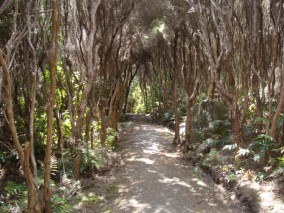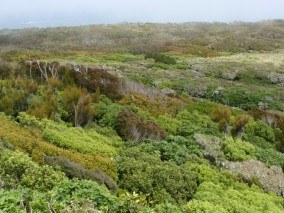Shrubland or “scrub” was generally considered to be wasteland by European settlers and most of it was cleared for farmland. Many people think of shrublands as a nuisance. However, shrubland plays a valuable role in our landscape. Areas of shrubland are home to many native plants and animals. In many areas they form ‘corridors’ between other areas of natural vegetation. Some areas of shrubland act as a nursery for regenerating forest. Other areas play an important role in buffering native forests or wetlands.
Types of shrublands
 Manuka Shrubland at Bluff HillShrubland areas in Southland can be divided into two main categories: short-lived (temporary) and long-lived (persistent).
Manuka Shrubland at Bluff HillShrubland areas in Southland can be divided into two main categories: short-lived (temporary) and long-lived (persistent).
Most people are familiar with short-lived shrubland. It is usually made up of manuka and common shrubs like five-finger, coprosmas, young pittosporums and wineberry. It forms a transitional covering, colonizing bare land. As the shrubs grow they change the microclimate of the land, allowing native forest species to colonize and slowly take over. For this reason, short-lived shrubland plants are often referred to as ‘nursery’ species and in time they will become mature forest.
Long-lived shrubland is only found in areas where the conditions are too harsh for native forest to take over. You’ll find it in our toughest areas, on mountains, in wetlands, along exposed coastlines and on poor soils. Because growing conditions can be harsh, long-lived shrubland species are often highly specialized.
Shrublands in Southland
 Coastal Shrubland at Bluff HillYou’ll find good examples of coastal shrubland at Bluff. Most of the forest on Bluff Hill is recovering from past burning, so has undergone a transition from shrubland to newly regenerating forest.
Coastal Shrubland at Bluff HillYou’ll find good examples of coastal shrubland at Bluff. Most of the forest on Bluff Hill is recovering from past burning, so has undergone a transition from shrubland to newly regenerating forest.
From the lookout at the top of Bluff Hill you can look down on manuka/fivefinger forest grading into manuka dominated shrubland and flaxland.
Long-lived coastal shrublands at Bluff contains coastal hebe and several other hardy salt tolerant species.
Shrubland plant list
Short-lived shrubland species tend to be fast growing and can quickly provide shelter for forest trees, which often require shelter from sun and wind in their seedling stage.
See our shrubland plant list to learn about what species make a good ‘nursery’ for future planting of forest trees.
Find out more
Find out more about Southland’s shrublands in the following booklet:
- Forest Remnants of the Southland Plains – A Guide to Enhancing Forest Remnants
Booklets are available from the Invercargill City Council.
